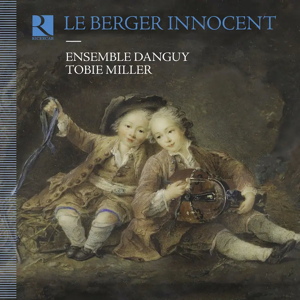
Le Berger Innocent
Ensemble Danguy/Tobie Miller
rec. 2022, Église Saint-Léger, Leymen, France
Includes booklet with French texts and English translations
Ricercar RIC448 [74]
Here is a disc that one might describe as being ornamental and yet it fills a small but noteworthy gap in the repertoire of the French rococo period. During the 18th Century the upper levels of French society became entranced with a fantasy world of Arcadian myth revolving around shepherds and shepherdesses. It became very fashionable to partake in fêtes which tried to emulate an artificial world that had never existed. The true hardships of raising animals in the harsh outdoors went unacknowledged as people frolicked about in romanticized costumes among carefully manicured bowers of flora. The culmination of this escapist behavior was the infamous (and very picturesque)Hameau de la Reine, Marie Antoinette’s toy farmhouse, where the Queen and her courtiers escaped from the rigors of daily life at Versailles, not to mention ignoring the increasingly desperate conditions of the poor classes of France. One could easily draw an analogy between this and the escapist trends of the present day, with the plethora of fantasy role-playing and other virtual realities made possible by new technologies. The Arcadian trend of the 18th Century did inspire much in the arts, including poetry, painting and music. One only has to look at images of languishing shepherd couples on French Toile fabrics to get the idea. Among the musical accomplishments of this era, Mozart’s operas Bastien und Bastienne and Il Re Pastore are excellent examples of these kind of works.
However, in France there was a different musical development on the pastoral front. Small rustic vocal cantatas called “Cantatilles” were produced by several composers which made the rounds of intimate musical gatherings and fêtes. One of the features of these works was the inclusion of the two rustic instruments that are most characteristic of the pastoral idiom: the musette (part of the bagpipe family) and the Vielle à roue (which we know today as a hurdy gurdy). This disc presents two cantatilles, along with a couple of simple airs that are mixed with other sonatas and works for small instrumental ensembles, including the vielle and musette.
There were a handful of composers who created the works this repertoire, who didn’t make it into the higher echelon of composers who worked for the French Court (apart from Joseph Bodin de Boismortier who did). Several of these less well-known men are represented on this CD. The disc opens with a larger-scaled cantatille about the shepherd Mirthil playing his “sweet” musette for his lover. Immediately the novelty of the arrangement for continuo and the pungent sound of the musette, combined with the scratchy sounds of the vielle hurtle out of the sound system with biting effect on the listener. This is lessened somewhat by the pure sound of soprano Monika Mauch. Ms Mauch is a happy discovery and hopefully will go far in the field of early music. She is certainly more gifted a singer than many I have come across in several important releases in the surge of French Baroque CDs that are tumbling out of the recording labels these days. She is at her very best in the most charming number on the album; a work which gives the disc its title, a delicate air called “Le Berger Innocent”. This lovely song describes the awakening of a shepherd appropriately named “Innocent” and his sweetheart “Simplette” who are awakened to carnal pleasures thanks to the intervention of a particularly naughty fly.
Interspersed with the vocal pieces are several sonatas and suites for the instrumental ensemble. The earthy sounds of the vielle, which can sound like a violin, the drones of a bagpipe, and a comb harmonica (sometimes all three simultaneously) might be an acquired taste for some listeners. The music that they play here runs the gamut of elegant leisureliness to more lively sounding dance movements. The sound of these two instruments, blending with the traditional harpsichord and other continuo players is novel and engaging. This disc isn’t going to change anyone’s world view but for a taste of a particularly rarified slice of musical and societal history it is a worthwhile investment. My encounter with this disc is sufficient to draw the conclusion that the giant upheaval of the French revolution was overwhelmingly inevitable.
It is worth noting that the booklet does not differentiate between the vielle (an early medieval violin), and the vielle à roue (the hurdy gurdy), the instrument used in this recording. The notes consistently refer to it as a vielle. Sticklers for accuracy should take note.
Mike Parr
Buying this recording via a link below generates revenue for MWI, which helps the site remain free.



Contents
Louis Lemaire (ca.1693-1750)
Cantatille ‘La Musette’
Cantatille ‘Les Plaisirs champêtres’
Monsieur Ravet (fl. 1750)
Premiere Sonate, “La Champêtre”
Jean-Baptiste Dupuits (?-1759)
Sixième Sonate à deux vielles
Quatrième Suite d’Amusements en Duo: Premier air – Second Air
Servais Bertin (ca.1687-1759)
Air pour la vielle et la musette: Tu ne m’écoutes point Lisette
Joseph Bodin de Boismortier (1689-1755)
Cinquieme gentillesse, Op. 45
Anonymous:
Le Berger innocent
Jean-François Boüin (ca.1716-ca.1781)
Les Folies d’Espagne, 4e Divertissement Champêtre
Performers
Ensemble Danguy:
Tobie Miller (baroque vielle), François Lazarevitch (musette), Alice Humber (baroque vielle), Ellie Nimeroski (violin), Caroline Ritchie (bass viol), Norah Hansen (bassoon), Sam Chapman (theorbo, guitar), Nadja Lesaulnier (harpsichord), Monika Mauch (soprano)

















